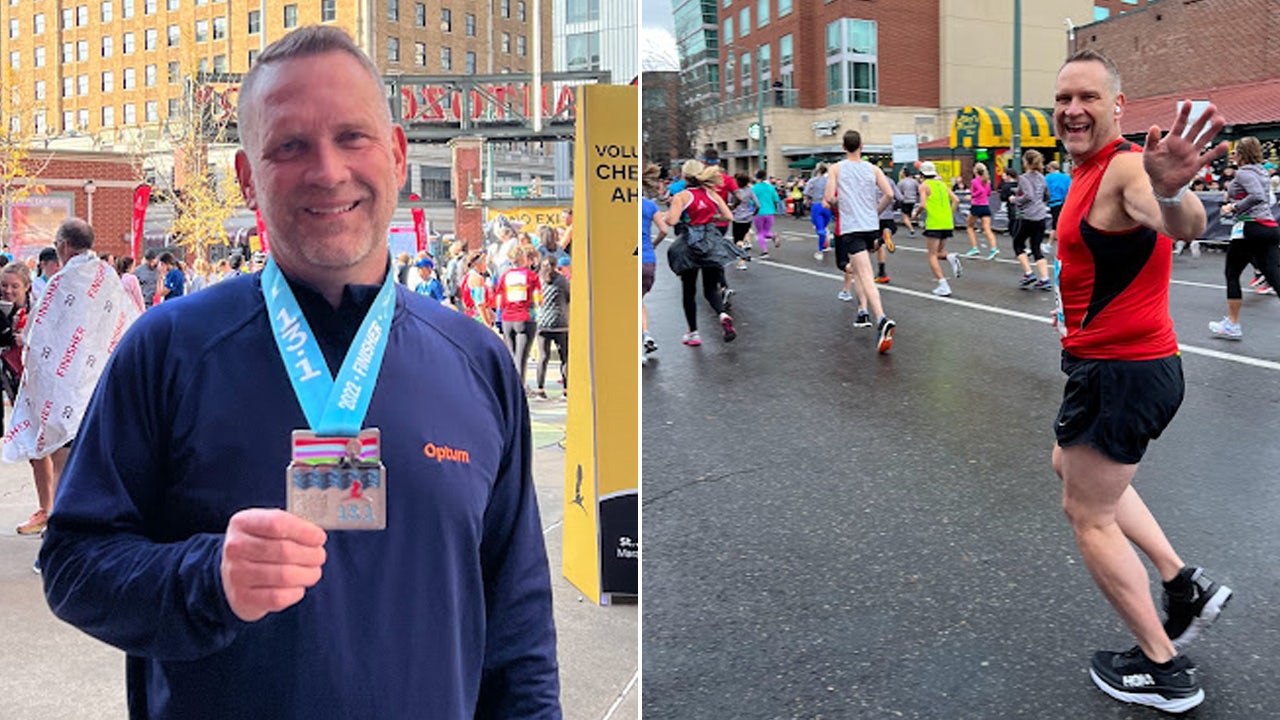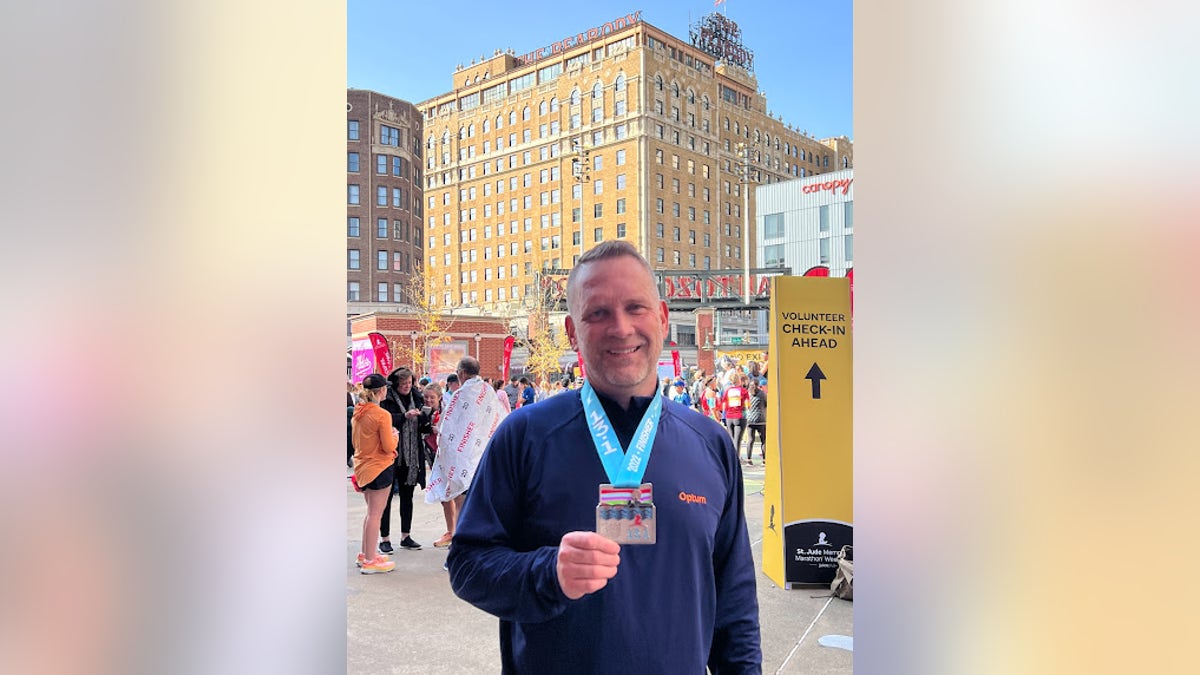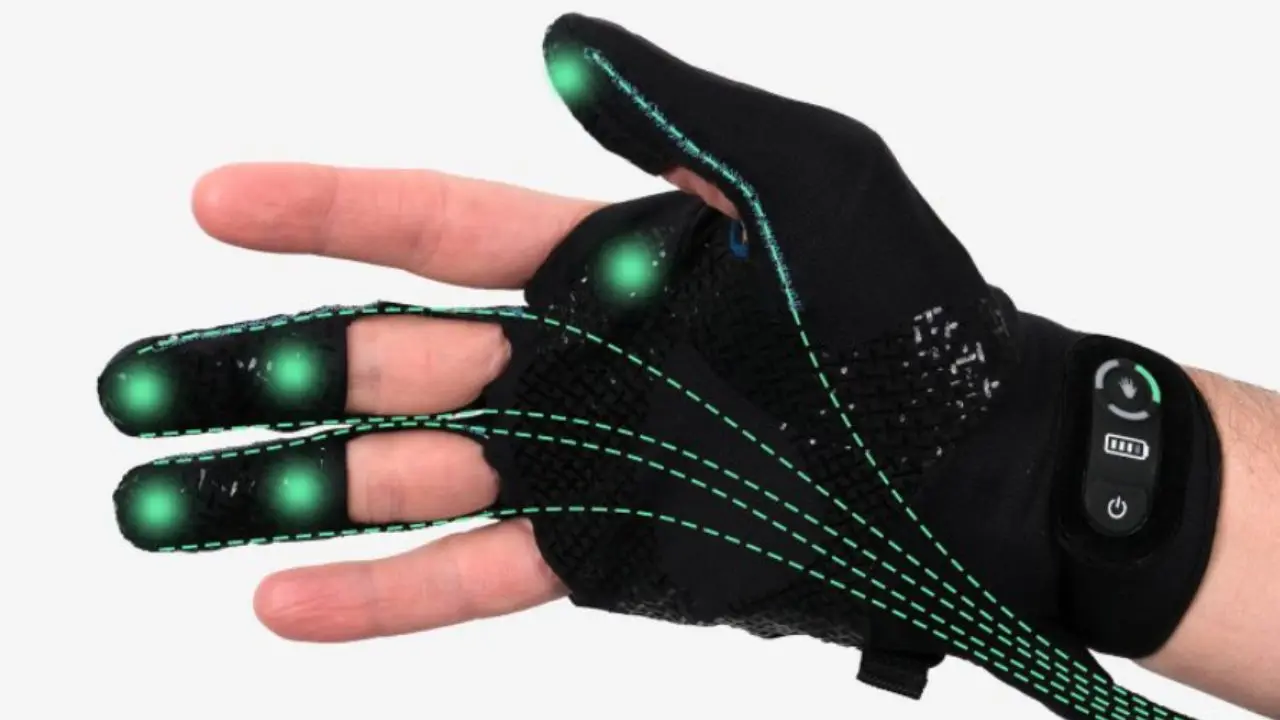Health
‘COVID paralyzed my diaphragm’: Marathon runner shares how the infection took his breath away

Someone with COVID-19 might expect to experience fatigue, cold and flu symptoms, and loss of taste and smell — but a paralyzed diaphragm would likely not be on the radar.
It was certainly a surprise to Gerald Branim, 55, a runner from Tennessee. His life took a drastic turn when COVID-19 damaged his lungs and diaphragm to the extent that he was unable to run or walk for a year.
Branim and his doctor, Matthew Kaufman of the Institute of Advanced Reconstruction in New Jersey, joined Fox News Digital in an interview to discuss Branim’s ordeal and recovery.
LARGEST-EVER COVID VACCINE STUDY LINKS SHOT TO SMALL INCREASE IN HEART AND BRAIN CONDITIONS
When Branim got COVID in Feb. 2021, he was a fit, healthy 52-year-old who ran marathons.
In spite of that, the infection caused significant lung damage. He spent two weeks in the hospital and three months out of work.
Gerald Branim, 55, was a marathon runner when he got COVID, which led to a paralyzed diaphragm that stopped him in his tracks. (Institute for Advanced Reconstruction)
For two months after leaving the hospital, Branim used a walker as he continued struggling with lung complications.
“For someone who had run marathons, it was quite humbling to have to walk with a walker for three months,” he said.
After rounds of high-dose steroids and lots of antibiotics, Branim’s chest X-rays finally showed that his lungs had cleared — but he was still having trouble functioning.
LONG COVID IS HIGHEST IN THESE STATES, SAYS NEW CDC REPORT
“I still couldn’t go upstairs without my oxygen dropping severely,” he recalled. “I couldn’t run 100 yards without my oxygen dropping into dangerous levels. I was severely out of breath.”
“That’s when they started saying something else was going on — that this shouldn’t be happening.”
“I couldn’t run 100 yards without my oxygen dropping into dangerous levels. I was severely out of breath.”
After 10 months of not being able to walk or run, Branim’s condition was finally diagnosed via a “sniff test,” which is also called a chest fluoroscopy or a video chest X-ray, where the patient is asked to breathe in and out.
Any paralysis will show up on the scan, as the diaphragm won’t move upon breathing.
What to know about diaphragm paralysis
Diaphragm paralysis — which is a “pretty rare condition,” according to Kaufman, Branim’s doctor — is paralysis of the diaphragm muscle, which is the primary breathing muscle.
Previous studies have estimated that the condition affects only about 1.31% of the population. In about 95% of cases, only one side is paralyzed, the doctor noted.
“We have two diaphragms, one on the right, one on the left,” he said.

Branim, far right, is pictured with his doctor, Matthew Kaufman, center, and another patient at the half-marathon they ran together after Branim’s surgery. (Institute for Advanced Reconstruction)
In cases where both sides are paralyzed, symptoms will be much more severe, usually requiring the patient to be put on oxygen.
“It’s become sort of a phenomenon,” Kaufman told Fox News Digital. “The phrenic nerve, which is the nerve that controls the diaphragm, seems to be an area where the COVID virus can have an impact.”
In some ways, he said, the condition can be considered part of long COVID, which is when symptoms of the virus linger for weeks, months or even years after infection.
SHOULD THE CDC DROP ITS 5-DAY COVID ISOLATION GUIDELINES? DOCTORS WEIGH IN
Most people with diaphragm paralysis won’t have difficulty breathing while sitting. Symptoms will typically emerge with exertion, such as walking or exercising, or when changing positions, such as lying flat in bed or bending over to tie their shoes, Kaufman said.
Some people are more susceptible than others, the doctor noted.
“We know that viruses tend to attack nerves in the body, as we’ve seen in Bell’s palsy,” he said. “And now we’re seeing it with COVID causing injury to the phrenic nerve.”

Branim set a goal of running a half-marathon within a year of his surgery date, which he achieved alongside his doctor in April 2023. (Institute for Advanced Reconstruction)
Because the condition is rare to begin with, he said, it’s not something that’s universally known.
“And then you take a condition like COVID, which causes respiratory symptoms from inflammation in the airways and lungs, and then you tie in what we consider to be a neuromuscular problem,” Kaufman said.
“A lot of times, the physician or patient will attribute it to airway inflammation, when in fact it’s a problem related to nerves and muscles that are part of the respiratory system.”
ASK A DOC: ‘WHEN IS A COUGH SOMETHING TO WORRY ABOUT?’
In some cases, patients will recover on their own, Kaufman said.
“We usually recommend a period of about six to 12 months of physical therapy, breathing exercises and cardiovascular fitness to try to see if this will come back on its own,” he said.
If improvement is not noticed in that time frame, surgical intervention becomes a possibility.

Branim emphasized the importance of patients serving as their own advocates. “Doctors are human — they don’t know everything,” he said. “So you have to advocate for yourself.” (Institute for Advanced Reconstruction)
In 2020 and 2021, Kaufman said he saw an uptick of patients who experienced diaphragm paralysis after having COVID. Although he is still seeing some cases, they are starting to trail off a bit.
“That could be because the classic COVID is not as virulent or severe,” he said. “Or maybe it’s because more people are immunized.”
Although the condition is generally not life-threatening, it can be more severe in patients who have existing respiratory conditions.
Racing toward recovery
After Branim’s diagnosis, his lung doctor advised him to continue to give it time to heal.
“But it wasn’t getting any better,” he said. “And I just wasn’t satisfied with that being my new quality of life.”
‘WELLNESS SHOTS’ AT HOME CAN HELP YOU BEAT THE COLD THAT’S HAMPERING YOU: TRY THE RECIPE
That’s when Branim turned to Google to research surgical options. He came across an article by Kaufman, a plastic and reconstructive surgeon who specializes in an area called peripheral nerve microsurgery.
Kaufman specializes in conditions that cause either pain or paralysis due to nerve damage of the peripheral nervous system.
After meeting with Kaufman in a telehealth visit, Branim was identified as a prime candidate for the surgery, which is called phrenic nerve reconstruction.
“It wasn’t getting any better — and I just wasn’t satisfied with that being my new quality of life.”
If he had waited much longer, he said, his diaphragm muscle would have atrophied and the surgery would no longer have been possible.
After a lot of back and forth with the insurance company, Branim finally got the green light to travel from Nashville to New Jersey for the procedure.
The surgery went smoothly, although Branim was told that it wouldn’t be an immediate improvement. Once the nerve is fixed, the muscle still needs time to strengthen and rehabilitate.

Studies have estimated that the condition affects only about 1.31% of the population. In about 95% of cases, only one side is paralyzed. (Institute for Advanced Reconstruction)
“Dr. Kaufman told me that it would probably take a year or two to recover fully, and was preaching patience — but I’m not a patient man in the slightest sense of the word,” Branim laughed.
He set a goal of running a half-marathon within a year of his surgery date.
After four weeks, Branim slowly began exercising again. After six months, he decided to lace up his running shoes and give it a try.
“My very first run after the surgery, I ran five miles,” he said. “I literally cried. At that point, it was like a light switch had been flipped.”
MASK MANDATES RETURN TO HOSPITALS IN NYC, SEVERAL OTHER STATES AMID RISE IN COVID, FLU CASES
Within six months, Branim had not only regained his ability to run, but exceeded his original goals, culminating in a half-marathon in April 2023.
In a triumphant twist, Kaufman, who is also a runner, joined his patient in completing the race in Asbury Park, New Jersey.
Now, Branim aims to raise awareness about diaphragm paralysis, an often-overlooked condition that is not on most doctors’ or patients’ radars.

Previous studies have estimated that the condition affects only about 1.31% of the population. In about 95% of cases, only one side is paralyzed. (iStock)
“None of my doctors had even heard of this surgery,” he said. “Had I not found the article about Dr. Kaufman and another runner online, I would have never been able to have the surgery — and I would absolutely not be running today.”
Branim emphasized the importance of patients serving as their own advocates.
CLICK HERE TO SIGN UP FOR OUR HEALTH NEWSLETTER
“Doctors are human — they don’t know everything,” he said. “So you have to advocate for yourself.”
For patients who are experiencing shortness of breath with exertion that persists for several months, Kaufman recommends visiting a primary care physician or pulmonary physician to get the necessary testing.
“While most tests will find more common ailments, it definitely makes sense to keep a paralyzed diaphragm on the list of things to rule out.”
For more Health articles, visit www.foxnews/health.

Health
Saunas have health benefits, but overuse is linked to dangerous health risks

Taking time to sit in a sauna can be a great way to decompress after a grueling workout or even a stressful day.
While in a sauna, you can add to the relaxation by reading your favorite book, listening to a motivational podcast or just by closing your eyes, taking deep breaths and sweating the stress away.
Saunas are commonly found at gyms and spas, but you can buy one for your home.
MAXIMIZE HAIR GROWTH WITH THESE OILS THAT CAN BE EASILY ADDED TO YOUR DAILY SELF-CARE ROUTINE
A sauna offers health benefits, but it’s also important to be mindful of risks.
- What are the different types of saunas?
- What are the health benefits that come from sauna use?
- How long is it safe to go in the sauna?
- Are there any risks of sauna use I should be aware of?
A sauna is full of health benefits, but it also poses risk if not used properly or if used with certain underlying health conditions. (iStock)
1. What are the different types of saunas?
A sauna is “a specific room heated to about 150 to 195 (F) degrees, and where the temperature and humidity of the room can be controlled with sprinkling water on the rocks in the heater/stove,” according to the North American Sauna Society’s website.
Some of the most commonly found saunas are wood-burning saunas, electrically heated saunas, manufactured sauna rooms, smoke saunas, steam rooms and infrared rooms.
For the most part, many of the health benefits are consistent no matter what type of sauna you use.
THE HEALTH BENEFITS OF MORINGA INCLUDE SETTLING INFLAMMATION, LOWER BLOOD SUGAR, ACCORDING TO EXPERTS
“While many benefits overlap, steam may be better for respiratory issues, far infrared for weight loss and recovery,” Dr. Brooke Jeffy, a board-certified dermatologist from Scottsdale, Arizona, and founder of youth skin care brand BTWN, told Fox News Digital via email.
2. What are the health benefits that come from sauna use?
There are several different health benefits that come along with sauna use.
“Both steam and dry saunas can have beneficial effects on respiratory conditions, cardiovascular disease and dementia,” Jeffy said.
“They also help stiff muscles and joints and increase circulation to the skin. Both steam and infrared saunas have beneficial effects on blood pressure. Infrared saunas may improve weight loss when combined with exercise and improve muscle recovery.”
CLICK HERE TO SIGN UP FOR OUR LIFESTYLE NEWSLETTER
The time at which you use a sauna doesn’t matter, according to Jeffy. Either a morning sweat or a relaxing sit in the sauna before bed can boast health benefits.
Many people also choose to hop in a sauna after a workout.
“Post-workout sessions help improve weight control and muscle recovery,” Jeffy said.

It’s common to sit in a sauna after completing a workout. (iStock)
3. How long is it safe to go in the sauna?
When in a sauna, make sure you keep track of how long you’ve been inside.
Many gym saunas have a clock, so you don’t have to take your phone inside, potentially causing it to overheat.
If there isn’t a timer or clock available, make sure to bring one with you or set an alarm to sound so you know when it’s time to exit.
For more Lifestyle articles, visit www.foxnews.com/lifestyle
“The maximum time to spend in the dry sauna or steam room is about 15-20 minutes,” Jeffy said. “Infrared sauna can be used longer, anywhere from 20-40 minutes.”
4. Are there any risks of sauna use I should be aware of?
While sauna use does include benefits, there are also risks you should be aware of if you decide to add it to your routine.
The risks include dehydration, heat exhaustion and stroke, according to Jeffy.

Make sure to drink water to keep yourself hydrated while in a sauna. (iStock)
To avoid potential dehydration, bring a bottle of water into the sauna with you.
If you aren’t a regular sauna user already, consider a slow progression to allow your body to adjust and slowly begin increasing the time you sit inside.
Lastly, if you are pregnant, sick, intoxicated or prone to dizziness, you should not use a sauna, according to Jeffy.
“Saunas should not be used if you have had a recent heart attack, or history of angina, aortic stenosis or congestive heart failure,” Jeffy added.
Health
‘Is it bad to skip breakfast if I’m not hungry?’: Ask a doctor

You’ve likely heard the old adage that breakfast is the most important meal of the day, but what if you’re just not hungry in the morning?
Is it OK to consistently skip the morning meal and hold off until lunch?
Fox News Digital asked some nutritionists about the potential ramifications of bypassing breakfast on a regular basis and their recommendations for optimizing metabolism with a healthy morning routine.
TRENDY BUBBLE WAFFLE, A ‘UNIQUE’ AND ‘FLAVORFUL’ TREAT, BEGAN IN HONG KONG AS ‘BELOVED’ STREET FOOD
While most experts agree it’s OK to skip breakfast once in a while, it’s generally beneficial to eat something within an hour or two of waking up.
While most experts agree it’s OK to skip breakfast once in a while, it’s generally beneficial to eat something within an hour or two of waking up. (iStock)
“Skipping breakfast regularly could lead to some unwanted side effects,” Shelley Balls, registered dietitian and owner at Fueling Your Lifestyle in Smoot, Wyoming, told Fox News Digital.
“It can lead to an overconsumption of foods in the following meals throughout the day. You may think you’re eating fewer calories, but you might actually be binging at lunch or dinner,” she said.
BREAKFAST IS SERVED AS HOMEMADE BEEF SAUSAGE STICKY BUNS OFFER A ‘DELICIOUS TWIST’
Never eating breakfast can also affect energy levels, she warned, as the body isn’t getting the carbohydrates and nutrients it needs to perform optimally.
There could also be a long-term effect of slowing down the metabolism, the expert said.
“Breakfast is meant to break the overnight fast, and can help jump-start your metabolism. So, over time, not eating breakfast could decrease your metabolism, as your body becomes more efficient with fewer calories,” Balls said.

Protein in the morning usually leads to a higher calorie burn and helps to reduce hunger later in the day, experts say. (iStock)
Breakfast has been associated with a bevy of benefits, including better weight management, better cognitive function, increased metabolism, improved energy and reduced hunger, according to Vanessa King, registered dietitian nutritionist and media spokesperson for the Academy of Nutrition and Dietetics in Oahu, Hawaii.
“Breakfast gives you an energy boost to power-start your day,” King told Fox News Digital.
“Not eating breakfast could decrease your metabolism, as your body becomes more efficient on fewer calories.”
“Breaking an overnight fast with a balanced breakfast significantly impacts well-being and overall health,” she added. “It’s important for everyone. And for children and teens, eating breakfast has been associated with better behavior and academic performance.”
If you’re not hungry within an hour or two of waking up, King suggests looking at your eating pattern.
“Are you snacking at night and it’s leaving you full in the morning? Try lighter snacks and allow more time between your last meal and sleep,” she advised.
The fasting factor
For people who are following a plan of intermittent fasting or time-restricted feeding, eliminating breakfast is a common way to maintain a shorter eating window and a longer fasting stretch, according to Dr. Jennie Stanford, an obesity medicine physician in Pennsylvania and medical contributor for Drugwatch.
“One main determinant here is how someone feels later in the day,” she told Fox News Digital.
FASTING-LIKE DIET COULD SLOW THE AGING PROCESS, STUDY SUGGESTS: ‘LIVING LONGER AND HEALTHIER’
If skipping breakfast makes you feel ravenous later in the day, ultimately causing you to overconsume at other meals, this is not recommended, the doctor said.
“However, if not eating breakfast doesn’t impact the calories and other macronutrients they consume as the day progresses, it may represent an opportunity to decrease overall calorie intake,” Stanford added.
Lighter options for when you’re not hungry
“If you’re not ready for a full meal, begin with something small within 30 to 60 minutes of waking,” recommends Chloë Ward, a functional diagnostic nutrition practitioner and certified integrative nutrition health coach in Santa Barbara, California.
“Even a light snack can help signal to your body that it’s time to start burning energy.”

“Breakfast gives you an energy boost to power-start your day,” an expert told Fox News Digital. (iStock)
Ward offers the following breakfast suggestions for someone who’s not generally hungry in the morning but wants to kick-start metabolism.
- Smoothies: A nutrient-dense smoothie with ingredients like spinach, a small amount of fruit, protein powder and healthy fats (like avocado or nut butter) can be a light yet satisfying option.
- Greek yogurt with berries: Greek yogurt is rich in protein and can be paired with a handful of berries and a sprinkle of nuts or seeds for added fiber and healthy fats.
- Overnight Oats: Preparing oats the night before with milk, chia seeds and a dash of cinnamon can create a light and easy-to-digest breakfast that’s ready when you wake up.
- Protein-rich snack: A hard-boiled egg, a piece of turkey or chicken, or a small serving of cottage cheese can be a quick and light protein boost.
- A piece of fruit with nut butter: Slices of apple or banana with a spoonful of almond or peanut butter offer a balance of carbs, protein and healthy fats without being too heavy.

Greek yogurt is rich in protein and can be paired with a handful of berries and a sprinkle of nuts or seeds for added fiber and healthy fats, a nutritionist said. (iStock)
Overall, experts agree that healthy options like fruits, whole grains, dairy, protein and vegetables provide the biggest benefit.
“Protein has a higher thermogenic effect than other macronutrients, meaning it requires more energy (heat) to break it down than either fats or carbohydrates,” Stanford told Fox News Digital.
CLICK HERE TO SIGN UP FOR OUR HEALTH NEWSLETTER
“As such, having protein in the morning usually leads to a higher calorie burn, at least temporarily.”
Protein also helps to reduce hunger later in the day, Stanford said.
For more Health articles, visit www.foxnews/health
“Protein doesn’t have to mean meat, if it sounds too heavy in the morning,” she noted.
“Other good protein sources include low-sugar Greek yogurt, eggs, low-carb breakfast wraps, cheese, protein oats, protein shakes or clean protein bars.”
“Even a light snack can help signal to your body that it’s time to start burning energy.”
If you really can’t tolerate food in the morning, Ward suggests starting the day with a glass of warm water, possibly with lemon.
“Warm water helps wake up your digestive system, aids in hydration and can boost your metabolism after a night of fasting,” she said.
Health
Hit a Weight Loss Plateau? A Dietitian Reveals 3 Ways To Break It

Sign Up
Create a free account to access exclusive content, play games, solve puzzles, test your pop-culture knowledge and receive special offers.
Already have an account? Login
Forgot your password?
Get back to the Sign In
Use left and right arrow keys to navigate between menu items.
Use escape to exit the menu.
-

 Connecticut1 week ago
Connecticut1 week agoOxford church provides sanctuary during Sunday's damaging storm
-

 Technology1 week ago
Technology1 week agoBreakthrough robo-glove gives you superhuman grip
-

 Politics1 week ago
Politics1 week agoClinton lauds Biden as modern-day George Washington and president who 'healed our sick' in DNC speech
-

 Politics1 week ago
Politics1 week ago2024 showdown: What happens next in the Kamala Harris-Donald Trump face-off
-

 News1 week ago
News1 week agoWho Are Kamala Harris’s 1.5 Million New Donors?
-

 Politics1 week ago
Politics1 week agoTrump taunted over speculated RFK Jr endorsement: 'Weird as hell'
-

 Politics1 week ago
Politics1 week agoVivek Ramaswamy sounds off on potential RFK Jr. role in a Trump administration
-

 World6 days ago
World6 days agoPortugal coast hit by 5.3 magnitude earthquake














